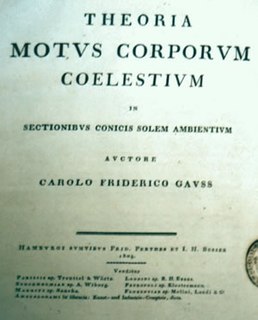Related Research Articles
The centimetre–gram–second system of units is a variant of the metric system based on the centimetre as the unit of length, the gram as the unit of mass, and the second as the unit of time. All CGS mechanical units are unambiguously derived from these three base units, but there are several different ways in which the CGS system was extended to cover electromagnetism.
In engineering and science, dimensional analysis is the analysis of the relationships between different physical quantities by identifying their base quantities and units of measure and tracking these dimensions as calculations or comparisons are performed. The conversion of units from one dimensional unit to another is often easier within the metric or SI system than in others, due to the regular 10-base in all units. Dimensional analysis, or more specifically the factor-label method, also known as the unit-factor method, is a widely used technique for such conversions using the rules of algebra.
In mathematics, an equation is a statement that asserts the equality of two expressions, which are connected by the equals sign "=". The word equation and its cognates in other languages may have subtly different meanings; for example, in French an équation is defined as containing one or more variables, while in English, any equality is an equation.

Numerical analysis is the study of algorithms that use numerical approximation for the problems of mathematical analysis. Numerical analysis naturally finds application in all fields of engineering and the physical sciences, but in the 21st century also the life sciences, social sciences, medicine, business and even the arts have adopted elements of scientific computations. The growth in computing power has revolutionized the use of realistic mathematical models in science and engineering, and subtle numerical analysis is required to implement these detailed models of the world. For example, ordinary differential equations appear in celestial mechanics ; numerical linear algebra is important for data analysis; stochastic differential equations and Markov chains are essential in simulating living cells for medicine and biology.
A physical constant, sometimes fundamental physical constant or universal constant, is a physical quantity that is generally believed to be both universal in nature and have constant value in time. It is contrasted with a mathematical constant, which has a fixed numerical value, but does not directly involve any physical measurement.

The International System of Units is the modern form of the metric system. It is the only system of measurement with an official status in nearly every country in the world. It comprises a coherent system of units of measurement starting with seven base units, which are the second, metre, kilogram, ampere, kelvin, mole, and candela. The system allows for an unlimited number of additional units, called derived units, which can always be represented as products of powers of the base units. Twenty-two derived units have been provided with special names and symbols. The seven base units and the 22 derived units with special names and symbols may be used in combination to express other derived units, which are adopted to facilitate measurement of diverse quantities. The SI also provides twenty prefixes to the unit names and unit symbols that may be used when specifying power-of-ten multiples and sub-multiples of SI units. The SI is intended to be an evolving system; units and prefixes are created and unit definitions are modified through international agreement as the technology of measurement progresses and the precision of measurements improves.
In dimensional analysis, a dimensionless quantity is a quantity to which no physical dimension is assigned, also known as a bare, pure, or scalar quantity or a quantity of dimension one, with a corresponding unit of measurement in the SI of the unit one, which is not explicitly shown. Dimensionless quantities are widely used in many fields, such as mathematics, physics, chemistry, engineering, and economics. Dimensionless quantities are distinct from quantities that have associated dimensions, such as time.
The Boltzmann constant is the proportionality factor that relates the average relative kinetic energy of particles in a gas with the thermodynamic temperature of the gas. It occurs in the definitions of the kelvin and the gas constant, and in Planck's law of black-body radiation and Boltzmann's entropy formula. The Boltzmann constant has dimensions of energy divided by temperature, the same as entropy. It is named after the Austrian scientist Ludwig Boltzmann.

The Gaussian gravitational constant is a parameter used in the orbital mechanics of the solar system. It relates the orbital period to the orbit's semi-major axis and the mass of the orbiting body in Solar masses.

Gaussian units constitute a metric system of physical units. This system is the most common of the several electromagnetic unit systems based on cgs (centimetre–gram–second) units. It is also called the Gaussian unit system, Gaussian-cgs units, or often just cgs units. The term "cgs units" is ambiguous and therefore to be avoided if possible: there are several variants of cgs with conflicting definitions of electromagnetic quantities and units.

In mathematics, a differential equation is an equation that relates one or more functions and their derivatives. In applications, the functions generally represent physical quantities, the derivatives represent their rates of change, and the differential equation defines a relationship between the two. Such relations are common; therefore, differential equations play a prominent role in many disciplines including engineering, physics, economics, and biology.
ISO 31-0 is the introductory part of international standard ISO 31 on quantities and units. It provides guidelines for using physical quantities, quantity and unit symbols, and coherent unit systems, especially the SI. It is intended for use in all fields of science and technology and is augmented by more specialized conventions defined in other parts of the ISO 31 standard. ISO 31-0 was withdrawn on 17 November 2009. It is superseded by ISO 80000-1. Other parts of ISO 31 have also been withdrawn and replaced by parts of ISO 80000.
Vacuum permittivity, commonly denoted ε0 is the value of the absolute dielectric permittivity of classical vacuum. Alternatively it may be referred to as the permittivity of free space, the electric constant, or the distributed capacitance of the vacuum. It is an ideal (baseline) physical constant. Its CODATA value is:
Lorentz–Heaviside units constitute a system of units within CGS, named for Hendrik Antoon Lorentz and Oliver Heaviside. They share with CGS-Gaussian units the property that the electric constant ε0 and magnetic constant µ0 do not appear, having been incorporated implicitly into the electromagnetic quantities by the way they are defined. Lorentz–Heaviside units may be regarded as normalizing ε0 = 1 and µ0 = 1, while at the same time revising Maxwell's equations to use the speed of light c instead.
Vacuum permeability is the magnetic permeability in a classical vacuum. Vacuum permeability is derived from production of a magnetic field by an electric current or by a moving electric charge and in all other formulas for magnetic-field production in a vacuum. Since the redefinition of SI units in 2019, the vacuum permeability μ0 is no longer a defined constant, but rather needs to be determined experimentally.

In numerical analysis, finite-difference methods (FDM) are a class of numerical techniques for solving differential equations by approximating derivatives with finite differences. Both the spatial domain and time interval are discretized, or broken into a finite number of steps, and the value of the solution at these discrete points is approximated by solving algebraic equations containing finite differences and values from nearby points.

A unit of measurement is a definite magnitude of a quantity, defined and adopted by convention or by law, that is used as a standard for measurement of the same kind of quantity. Any other quantity of that kind can be expressed as a multiple of the unit of measurement. For example, a length is a physical quantity. The metre is a unit of length that represents a definite predetermined length. When we say 10 metres, we actually mean 10 times the definite predetermined length called "metre". Measurement is a process of determining how large or small a physical quantity is as compared to a basic reference quantity of the same kind.
Calculation in kind or calculation in-natura is a way of valuating resources and a system of accounting that uses disaggregated physical magnitudes as opposed to a common unit of calculation. As the basis for a socialist economy it was proposed to replace money and financial calculation. Calculation in kind would value each commodity based only on its use value, for purposes of economic accounting. By contrast, in money-based economies, a commodity's value includes an exchange value.
In particle physics and physical cosmology, Planck units are a set of units of measurement defined exclusively in terms of four universal physical constants, in such a manner that these physical constants take on the numerical value of 1 when expressed in terms of these units.

A coherent system of units is a system of units used to measure physical quantities that are defined in such a way that the equations relating the numerical values expressed in the units of the system have exactly the same form, including numerical factors, as the corresponding equations directly relating the quantities.
References
- 1 2 Thompson, Ambler. Guide for the Use of the International System of Units (SI): The Metric System (PDF). DIANE Publishing. ISBN 9781437915594.